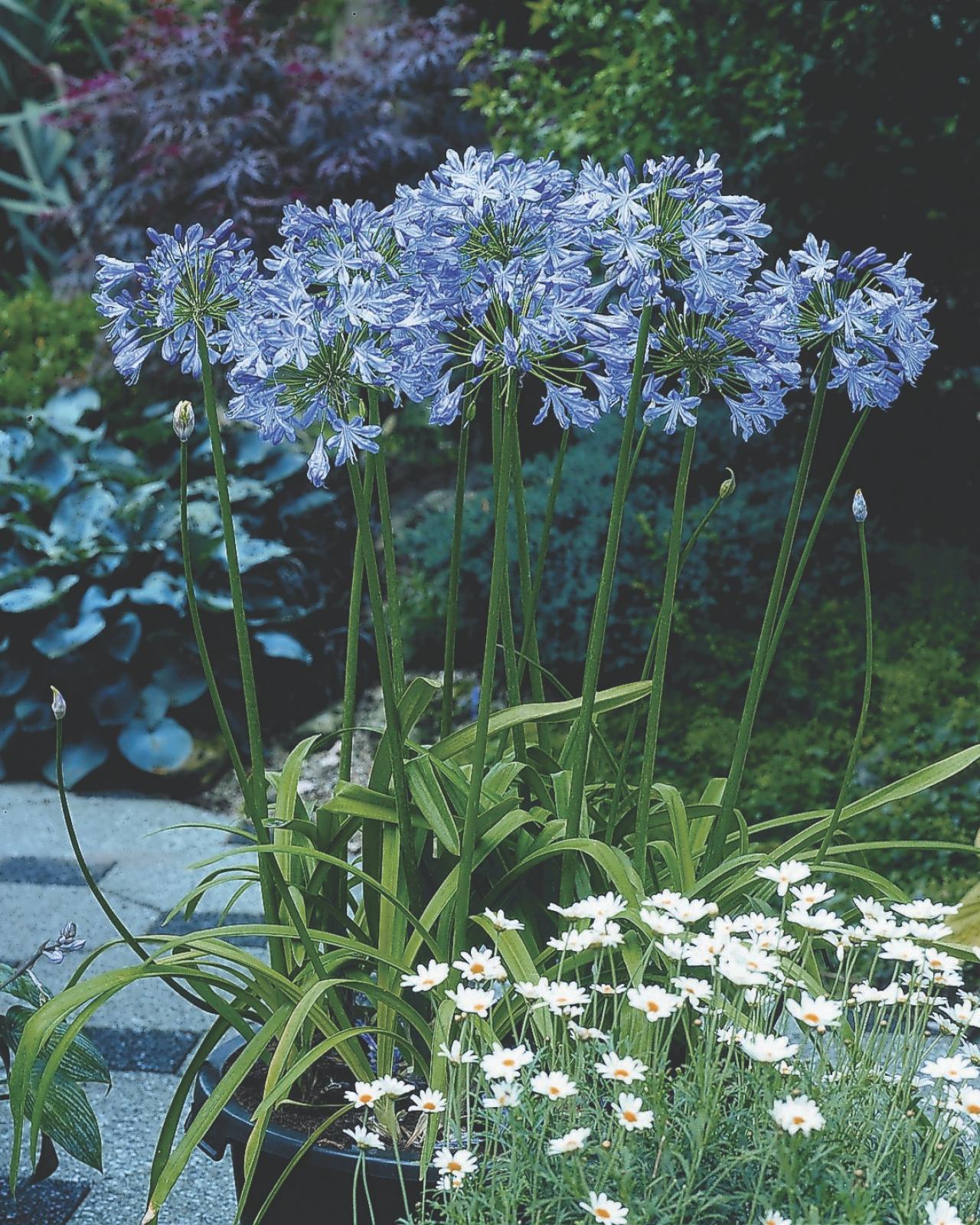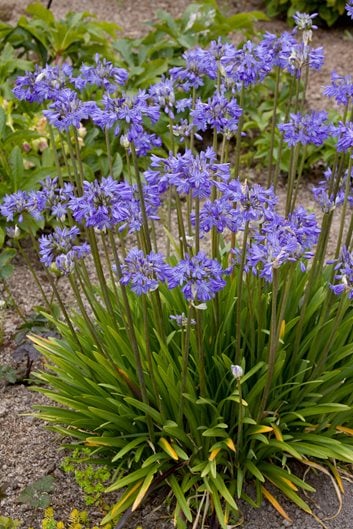Usual Agapanthus Troubles and Just How to Fix Them
Usual Agapanthus Troubles and Just How to Fix Them
Blog Article
Letting Loose the Secret to Effective Agapanthus Farming: Idea for a Flourishing Yard
In the realm of horticulture, cultivating agapanthus successfully requires a tactical approach that includes numerous facets of plant care. With mindful focus to detail, one can open the tricks to supporting these sensational blossoms, leading to a garden that flourishes with elegance and vibrancy. By comprehending the nuances of agapanthus cultivation, one can produce a setting where these plants prosper and grow generously. In the complying with conversation, we will discover vital pointers and techniques that will lead you in the direction of a flourishing agapanthus yard, using understandings right into finest practices, soil problems, watering methods, and a lot more.
Planting Agapanthus: Ideal Practices
When planting Agapanthus, appropriate dirt prep work is crucial for guaranteeing successful growth and growth of these lovely blossoms. Agapanthus, typically referred to as Lily of the Nile or African lily, thrives in well-draining dirt with a slightly acidic to neutral pH level - Agapanthus. Prior to planting, it is important to change heavy clay dirts with organic issue such as compost or peat moss to enhance drain and offer vital nutrients for the plants
To plant Agapanthus, select a place that obtains complete sunshine to partial color, as this will certainly advertise healthy and balanced development and bountiful flowering. Dig a hole twice the size of the plant's origin sphere and put the Agapanthus at the exact same depth it was previously growing. Carefully backfill the opening with dirt, pushing down firmly to remove any air pockets around the origins.
Water the newly grown Agapanthus thoroughly and continue to maintain the soil uniformly moist, particularly throughout the plant's active growing period. Agapanthus. Using a balanced fertilizer once a month can better support the plant's development and flowering. By complying with these finest techniques for growing Agapanthus, you can create a stunning display screen of these fascinating flowers in your yard
Ideal Dirt Conditions for Agapanthus
For optimal development and growing success of Agapanthus plants, making sure the soil conditions are excellent is essential. Agapanthus likes soil that is abundant in nutrients, so integrating a well balanced plant food throughout the expanding season can promote healthy growth and vivid blossoms.

Watering and Feeding Tips
To ensure healthy and balanced development and lively flowers, proper watering and feeding techniques are necessary for effective Agapanthus farming. Agapanthus plants benefit from routine watering, specifically throughout the growing period.
When it pertains to feeding Agapanthus, a well balanced fertilizer with equal parts nitrogen, phosphorus, and potassium can be used in the springtime site to advertise healthy and balanced development and blooming. Slow-release plant foods are ideal for giving nutrients progressively over a prolonged duration. Prevent over-fertilizing, as this can result in excessive vegetation development at the expense of blooms.
Additionally, integrating organic issue like compost right into the soil can enhance nutrient levels and boost soil structure, aiding in the total health and wellness of the Agapanthus plants. By following these watering and feeding ideas, gardeners can guarantee their Agapanthus plants prosper and produce magnificent display screens of blossoms.
Pruning and Deadheading Techniques
Correct pruning and deadheading strategies play a crucial duty in maintaining the health and wellness and aesthetic appeals of Agapanthus plants, enhancing the important techniques of watering and fertilizing for effective cultivation. Pruning Agapanthus includes removing invested blossom heads, yellowing or dead leaves, and total shaping of the plant to advertise better development. Deadheading, the process of eliminating faded flowers, not just boosts the plant's look however additionally motivates more growing.
When deadheading Agapanthus, it is a good idea to trim off the flower stem at the base using sharp, tidy shears. This process redirects the plant's power from seed manufacturing back right into root and vegetation development, promoting a much healthier and more robust plant. Normal deadheading can prolong the growing duration of Agapanthus and prevent self-seeding, which can result in congestion.
In regards to trimming, Agapanthus generally benefits from a light trim after blossoming to tidy up the plant and motivate fresh development. Reducing back the invested blossom stems and removing any dead or damaged vegetation assists preserve the plant's vigor and general look. Nevertheless, it is necessary to avoid cutting into the crown of the plant, as this can weaken its health.

Protecting Agapanthus From Pests and Diseases
Executing reliable bug and illness management strategies is critical to guarding the health and wellness and vitality of Agapanthus plants in cultivation. Agapanthus are usually sturdy plants, but they can still succumb to numerous insects and conditions if not properly looked after. One usual insect that influences Agapanthus is the Agapanthus borer, Homepage a caterpillar that tunnels right into the plant, triggering damages to the blossoms and leaves. To stop problems, normal assessment of the plants is necessary. If borers are detected, they can be manually removed, or insecticidal soap can be utilized as a control measure.
Along with pests, Agapanthus are susceptible to conditions such as root rot and fungal fallen leave areas. These concerns can often be protected against by guaranteeing proper drainage and preventing overwatering. Impacted components of the plant should be promptly removed to protect against further spread if signs of disease appear. Fungicides may additionally be made use of as a treatment step, complying with the producer's directions carefully. By staying alert and resolving bug and illness problems without delay, garden enthusiasts can help their Agapanthus grow and thrive.

Conclusion
In verdict, effective cultivation of agapanthus requires appropriate growing strategies, excellent soil problems, appropriate watering and feeding, regular trimming and deadheading, and defense from parasites and illness. By complying with these methods and pointers, gardeners can make sure a prospering yard loaded with lovely agapanthus blossoms. Agapanthus. Keep in mind to maintain regular treatment and interest to detail to advertise the health and durability of these stunning plants
When planting Agapanthus, correct soil preparation is necessary for making sure successful growth and growth of these lovely flowers.Water the freshly planted Agapanthus completely and continue to keep the soil evenly wet, especially during the plant's active expanding period.For optimum development and blooming success of Agapanthus plants, ensuring the soil conditions are ideal is important. When planting or transplanting Agapanthus, make sure the soil official site is well-prepared to supply the necessary structure for the plants to establish themselves efficiently. One common pest that influences Agapanthus is the Agapanthus borer, a caterpillar that passages into the plant, creating damage to the leaves and blossoms.
Report this page